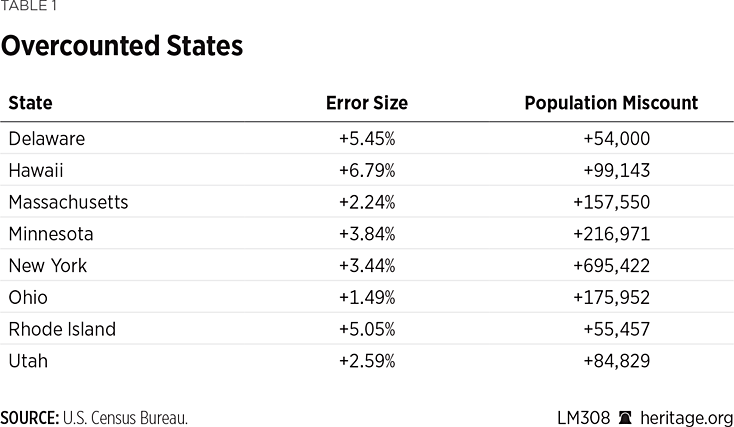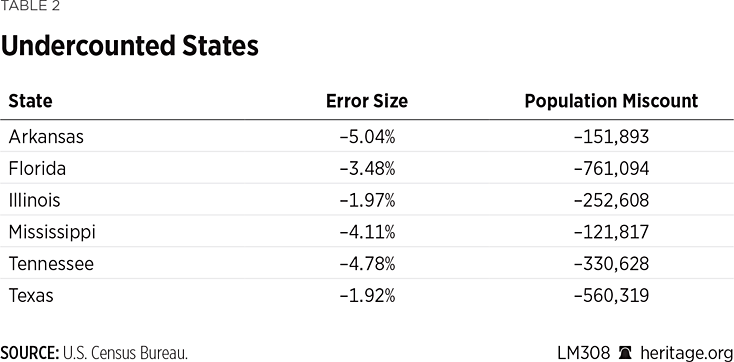In a shocking report that has not received the attention it deserves, the U.S. Census Bureau recently admitted that its 2020 Census count of the American population was incorrect in at least 14 states.REF And those mistakes were costly to certain states in terms of congressional representation, number of electors, and money those states are likely to receive from the federal government during the next decade. To put the scope of these mistakes into perspective, contrast the errors in the Census Bureau’s latest recount (the 2020 Post-Enumeration Survey, or PES) with the recount from a decade ago (the 2010 Post-Enumeration Survey)—in which there was a net overcount of a mere 0.01 percent (36,000 people), a statistically insignificant error.REF
As explained below, as a result of these errors, Florida did not receive two additional congressional seats and Texas did not receive one more congressional seat. Meanwhile, two other states, Minnesota and Rhode Island, each retained a congressional seat that they should have lost, and Colorado gained a new seat to which it was rightfully not entitled.REF The harms flowing from these mistakes impact more than just congressional representation, which also affects the number of electors from those states since they are calculated by the number of Senators and Representatives in each state.REF Because the Treasury and other federal departments will continue to use the original, official Census numbers (and not the new numbers contained in the PES), these errors will affect $1.5 trillion in funding received by states in federal appropriations during the next decade in disbursements that are distributed based on the population of each state.REF
Applicable Law
The Constitution directs that an “actual Enumeration” be conducted every 10 years “in such Manner as [Congress] shall by Law direct” to determine the number of seats to which each state is entitled in the House of Representatives.REF Congress has delegated responsibility for conducting the census to the Secretary of the Department of Commerce “in such form and content as he may determine,”REF and that job is carried out by the Census Bureau within the Commerce Department.
The total number of Members of the House of Representatives was fixed at 435 by the Permanent Apportionment Act of 1929.REF Under that act and a calculation known as “the method of equal proportions,” each state, in essence, is entitled to the number of Representatives that the proportion of “the whole number of persons” in that state bears to the total population of the United States.REF No matter how small its population, each state is entitled to at least one representative.REF Furthermore, in 1999, the U.S. Supreme Court held that the Census Bureau must conduct an actual count because the Census Act of 1976 does not allow statistical sampling.REF
Apportionment Under the Original 2020 Census Report
Under the 2020 Census enumeration released on April 26, 2021, the total apportionment population of the United States was reported as 331,108,434. After application of the “method of equal proportion,” five states each gained one new congressional seat: Colorado, Florida, Montana, North Carolina, and Oregon. Texas gained two new seats. Due to population decreases, seven states each lost one congressional seat: California, Illinois, Michigan, New York, Ohio, Pennsylvania, and West Virginia.REF
2020 Post-Enumeration Survey
The 2020 PES is a survey in which the Census Bureau interviews a sampling of households across the country and then compares the results with actual responses from those households in the original 2020 Census records. For the 2020 PES, the Census Bureau completed 114,000 interviews out of a sample size of 161,000.REF As the Census Bureau warns, the PES “cannot be used to change the final census count,” but can be used to determine how to “improve future censuses.” Moreover, it does not cover remote areas of Alaska or individuals living “in group quarters, such as college dormitories, nursing homes, prisons, etc.”REF
According to Tim Kennel, the Assistant Division Chief for Statistical Methods at the Census Bureau, the PES provides information on “how many people were correctly counted in the census, missed, or erroneously enumerated.” But it cannot be used to explain why these overcounts and undercounts occurred because the “PES was designed to measure net coverage error, but not designed to answer questions about the root causes of coverage error.”REF
The PES was modified “in response to [the COVID-19] pandemic.” The “most visible modification was delaying the field work,” which apparently led to the PES actually “having higher response rates than many other surveys.” “Field work” refers to the “surveys and in-person interviews” that are conducted by the Census Bureau for the PES.REF
The errors in the original Census cannot be blamed on the fact that, for the first time, the Internet was used extensively by the public to respond to the Census. The majority of Americans, “over 206 million people, were counted in the census through an internet response. Over 96% of these people were correct enumerations,” according to Kennel.REF
Moreover, Kennel said that about 37 million people responded using paper questionnaires and those responses also had “high correct enumeration rates.” Moreover, of the 22 million people who did not initially respond, but later participated after being contacted by the Census Bureau, they also had “low erroneous enumeration rates.” The highest error rate seemed to be with the 15 million people counted through proxy, meaning that information was provided by “a neighbor, or a landlord, or someone else outside the household.”REF
An innovation of the 2020 Census that was directed by former President Donald Trump “was the use of administrative records,” i.e., existing records on the public in federal agencies and departments, such as the Social Security Administration and the Department of Agriculture. The Census did not use those records to determine citizenship status but did use them “to enumerate non-responding households,” and this method of using existing administrative records—despite criticism that it was not technically feasible and would not be accurate—“met the criteria of being correct enumerations.”REF
All of this leaves unexplained the reasons for the errors made in the 2020 Census, particularly when there were no such overcounts and undercounts in the 2010 Census.
The Errors in the 2020 Census
According to the PES, the Census Bureau overcounted the population in eight states and undercounted it in six states. The Census Bureau is unable to identify what groups were undercounted or overcounted in a state or where the error occurred geographically because “sample sizes within most states do not support such estimates.”
The following states were overcounted (with the size of the error) by the Census Bureau:

The following states were undercounted (with the size of the error) by the Census Bureau:REF

If the PES survey is correct, then the Census Bureau’s assessment of the “Top Ten Runner-Up States to Almost Gain Another Congressional Seat” is also wrong. Ranked by priority, the Census Bureau listed New York and Ohio as the first and second runners-up, followed by Texas and Florida. New York supposedly only needed an additional 89 individuals to gain another congressional seat. But since New York was overcounted by 3.44 percent and Ohio was overcounted by 1.49 percent, they clearly were not the top two states.REF
Effect on Apportionment
As a result of these errors, Florida did not receive two additional congressional seats, Texas lost out on an additional seat, Minnesota and Rhode Island each retained a congressional seat that should have been lost, and Colorado gained a new seat to which it had no right.
Florida, for example, was undercounted by 761,094 individuals while it only needed “around 171,500 more residents to gain an extra seat.”REF Texas needed only “189,000 more residents to gain another congressional seat” but was undercounted by 560,319 residents.REF Minnesota would have lost a congressional seat if the Census had counted 26 fewer residents; the PES says Minnesota was overcounted by 216,971 individuals.
Similarly, Rhode Island would have lost a seat if the Census had counted 19,000 fewer residents; the Census overcount for the state was 55,457.REF According to the Associated Press, the director of the advocacy group Common Cause in Rhode Island, John Marion, said that “it was difficult to pinpoint exactly why Rhode Island would have such a large overcount,” but the state is “essentially the beneficiary of a statistical anomaly,” and, “as a result, we’ll have more representation in Congress for 10 years.”REF
Legal Remedies
There do not appear to be any statutory legal remedies for this problem. As the Census Bureau correctly noted, the errors will not change the officially reported 2020 Census counts or change the apportionment calculation for the states.REF There is no provision in the federal statute (2 U.S.C. § 2a) governing apportionment after each decennial Census for a readjustment of the numbers or giving states a statutory right of action to sue the Census Bureau.
Certainly, under the holding of the Supreme Court in Department of Commerce v. U.S. House of Representatives,REF states and their residents had standing to sue based on a constitutional claim that the enumeration conducted by the Census Bureau was inaccurate and would deprive them of congressional representation. But that alone may not be of much help.
Department of Commerce v. U.S. House of Representatives. In this 1999 case, both the House of Representatives and four counties, along with residents of 13 states, filed two separate lawsuits (that were consolidated) contesting the Census Bureau’s plan to use statistical sampling in the 2000 Census to help correct any possible undercount. The Court recognized that residents of those states did have Article III standing to sue because they had a concrete injury in the potential dilution of their voting strength due to the loss of congressional representation under the statistical sampling methods the Census Bureau was planning to use, as well as its potential effect on intrastate redistricting.REF
However, the Court never reached the constitutional issue because it decided that the statistical sampling proposed by the Census Bureau violated the Census Act of 1976. According to the Court, while that Act allows statistical sampling procedures and special surveys when collecting broad demographic data, it does not allow such sampling or surveys to be used “in the determination of population for purposes of apportionment.”REF
Thus, while states like Texas and Florida may have standing to sue because of the dilution of the vote of their states’ residents due to the loss of congressional representation, they face the problem that the PES is based on a special survey of a limited sampling of households and is not an “actual Enumeration” of all of the households in the U.S. Under the holding in Department of Commerce, they would have a very difficult time convincing a court, including the Supreme Court, to hold that the 2020 Census was inaccurate based on a sample survey that federal law already says cannot be used to determine the population used for apportionment—although it is possible that the discovery process in the litigation could be used to try to determine the cause of these errors.REF
Moreover, any remedy would be difficult to fashion since the Census is geared to providing a count of the population of the country on one specific day, in this case April 1, 2020.REF A remedy that involved ordering the Census Bureau to conduct another actual count in the 14 affected states would not only be very expensive but would provide numbers on a different date than the original Census whose population totals would still be in effect for the rest of the states. This would raise fundamental fairness issues given the high mobility of American society. The concept of conducting a new Census of the entire nation to deal with this problem also seems impractical.
Federal Funding. But while litigation challenging the apportionment would likely be a dead end, a focus on federal funding could, potentially, yield something positive. The constitutional rules requiring an actual enumeration of the population for apportionment do not apply to the distribution of federal funds based on the 2020 Census population count. There is no prohibition on states trying to use the PES to convince a court that the distribution of a state’s share of federal funds should be adjusted to take into account the errors found by the PES. Furthermore, there is no constitutional prohibition on Congress implementing such a requirement through federal law.
Conclusion and Recommendations
Assuming the accuracy of the 2020 Post-Enumeration Survey and the errors it has revealed, certain states will be shorted in their congressional representation until after the 2030 Census, while other states will get more representation than they are entitled to. Fashioning a legal remedy to fix this problem could pose a significant obstacle and may not be practical.
Regardless, though, Congress should investigate the conduct of the 2020 Census to find out the cause of these errors and mandate whatever changes are required to minimize, if not eliminate, such problems in future counts. An essential part of such an investigation would be determining why there were no such statistically significant errors in the 2010 Census in contrast to the 2020 Census.
Congress should also consider changes in federal appropriations law to determine if federal funds should be distributed to the states based on the corrected numbers as determined by the PES, which itself requires an investigation and examination of the accuracy of the methods used in the PES.
Hans A. von Spakovsky is Manager of Election Law Reform Initiative and Senior Legal Fellow in the Edwin Meese III Center for Legal and Judicial Studies at The Heritage Foundation.



